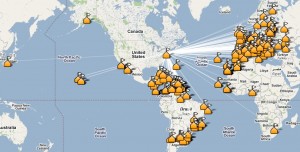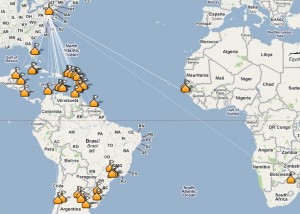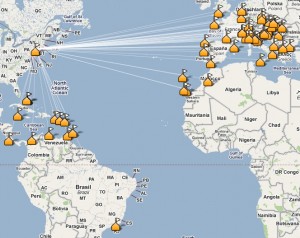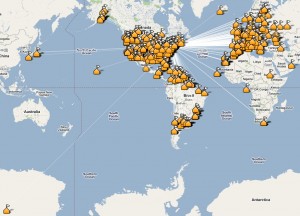Whata great day! It started around 7:30am at the Crowne Plaza and a hearty breakfast with a large group of energetic hams from all over the world. After a brief intro by KL3R, K1DG Doug gave an enthusiast presentation on contest ethics with many similarities to the sport of birdwatching called Birding.
For the first session I attended a presentation by N0AX on beverage receiving antennas and general contesting tips. It was a good overview and specifics on options for locations where you don’t have 100s of feet for beverage wires. The 2nd half of Ward’s presentation was general tips and kinks with some maybe obvious tips that fly out of your head in the heat of a contest. Preparation, execution and Run, Run, Run are key.
The second session I attended was Getting Started in RTTY Contesting. Though I might not consider myself as someone that is a true beginner, I’ve never been to any formal discussions on RTTY and this session proved very enlightening. The session was given by Ed Muns, W0YK, one of the world’s best in RTTY contesting. It had a very informative technical discussion of a RTTY signal, AFSK vs FSK and setup followed by setting up MMTTY. Ed prefers space vs dash between data elements in an exchange, a continuining discussion/debate on RTTY reflectors.
The next session was Advanced RTTY Contesting again presented by Ed, W0YK/P49X. Ed showed a single screenshot with multiple decoding profiles for the same signal to catch the rare transmission where 1 profile decoded the signal better which isn’t something I had considered but will check out when I’m back home. He also brought up a bunch of options to consider for MMTTY/N1MM to optimize the user/interactions of the programs. The discussion of Ed’s setup and how he operates is just mind-boggling to the average man.
We then made our way to lunch where we had a eyeball QSO contest before the afternoon sessions got underway. I ended up coming in with a group of folks that finished 3rd overall.
After lunch I attended the session by Randy, K5ZD, on SO2R operations. Randy covered areas on what skills to develop, options on equipment needed or to help with SO2R, and ergonomic design.
Th next session was a Q&A session on the Reverse Beacon Network and contesting software led by Peter, N4ZR. Peter gave an overview of the RBN, some suggestions & considerations for using it, and some insight into other developments that are underway. A question was asked about a version to support RTTY but the developer appeared not to be to interested in that. There was also a bit of discussion at the end about interfacing a CW decoding program with N1MM but nothing appears to be in the works with that either.
The final Q&A session was with W0YK, Ed, about any RTTY questions folks had. Ed gave more insight into the profiles he uses and a group discussion on setting things up. I asked a question about the reasoning behind people using .3 and .8 as the frequencies such as 14080.3 and 14080.8 and they said their radios aren’t like that. I’ll have to figure out what on my setup (radio, N1MM or MMTTY) is causing it to show that way after I get home.
Contest University wrapped up with a discussion on radio performance by NC0B. He provided a tremendous amount of detail on the testing he does for radios. Tim, K3LR, wrapped things up for the day around 5pm. Though I was there from 7:30am – 5:00pm, it felt like the day flew by. I could have spent hours more talking with the experts as well as the other participants. It was nice meeting a bunch of folks that came up to me or that I spoke with where we recognized each other’s call signs. I’d definitely sign up for Contest University again whenever I do get back to Dayton. It was extremely informative, well run and just a lot of fun. Thanks to all the folks that put it together and ran the sessions – magnificent job!
Tomorrow I’ll head over to the flea market/arena for 2 days of walking and looking at a sea of equipment. The weather looks to be outstanding both days.
73,
K2DSL





